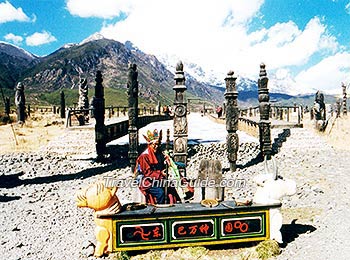 |
| Dongba Gods' Garden |
The smart and unsophisticated
Naxi people who have long inhabited Lijiang preserve the unique and profuse Dongba Culture. In fact, a great number of scholars and travelers are attracted to this mysterious place more for the culture than its charming sceneries. Dongba Culture is of a religious nature and make up the most important component of the ancient Naxi culture.
However, before the form of the Dongba Culture, the Naxi people in Lijiang followed the native religion of sorcery. During the Tang (618-907) and Song (960-1279) dynasties, a series of the other cultures, such as the
Tibetan Bon Religion,
Buddhism and
Taoism, were introduced into this region, affecting the native religion. Along with the impact and blending among these various cultures, the new Dongba Religion was founded. The Dongba Culture is said to been passed on by the Dongbas who were sages that integrated song, dance, the classics, history, painting and medicine. They enjoyed a high social position within the Naxi group because they were considered as mediums between humans, gods and ghosts, as well as are able to remove disasters and guarantee good fortunes. At present, there are no more than 30 Dongbas living in Lijiang, so it is a memorable experience for travelers to visit them.
 Dongba Characters
Dongba Characters
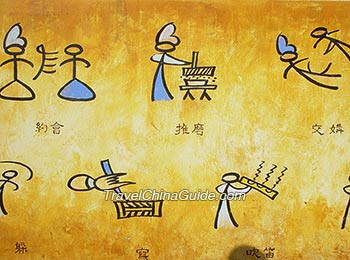 |
| Dongba Characters |
The immense Dongba Culture consists of its writings, scriptures, paintings, dance and music. Amongst them, the characters are not surprisingly the soul. Enjoying a history of over 1,000 years, it is still used by a few Naxi people even now. At first, the character was just a kind of hieroglyphic recorded on wood and stone. Later, with the use of paper, the use of characters gained popularity and gained its formal name. As a rare cultural treasure for all mankind, the Dongba character is the only existing hieroglyphic in China and praised to be the 'Living Fossil' showing the characters' origin and development of human society.
 Dongba Scriptures
Dongba Scriptures
All the scriptures were written in the picture-like characters, so they are not interpretable by ordinary folk. However, under the help of the Dongbas, some scriptures were translated into Mandarin and shown to readers at the end of the last century. These scriptures contain almost all aspects of the Naxi people, ranging from the nation's legends and history to traditional dancing and music. Now, these scriptures are kept in many countries other than China, such as the United States of America, Canada, Japan, Britain, France, Germany and Austria.
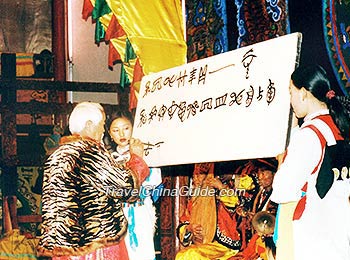 | | Writing in Dongba Characters | | 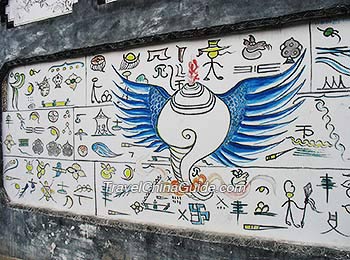 | | Colorful Dongba Paintings of Naxi People | |
 Dongba Paintings
Dongba PaintingsTraditionally, the exquisite and colorful Dongba paintings completely reveal the beliefs and good wishes of the Naxi people. Some of them are drawn to depict the daily lives of locals. The most famous one is the Painting of Sacred Road to Heaven which is approximately 14 meters long and 0.26 meters wide. This painting tells the story of how the dying man's soul is released from suffering. Vivid scenes describe how he passes into Hell, the human world, the natural heaven and finally Heaven. Nowadays, local artisans have created a series of modern Dongba paintings that retain the essence of those from more traditional times.
 Dongba Dance and Music
Dongba Dance and Music
The same to the other minorities, dance and music play vital roles in the Naxi people's daily life. The classical Naxi dance is the Dongba dance which is a kind of religious dance being played in the sacrifice events. However, most of these dancing show the locals' fight against the natural world and the forces of evil. There are about 60 kinds of dance recorded in two Dongba scriptures, including animal dance, sword and bow dance as well as the God dance. In fact, most of dance movements prefer to imitate animals, such as tiger, elephant, frog, monkey and eagle.
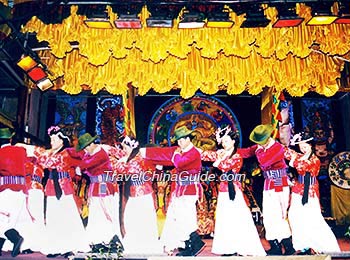 | | Dancing Mosuo People, Lijiang | | 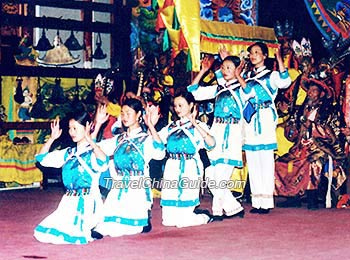 | | Dongba Dancing and Musical Show | |
In the sacrifice events of Dongba Religion, the dance is usually accompanied with the Dongba music (also the
Naxi Ancient Music). The content of these music is mainly derived from the scriptures and widely singing by the Naxi people. The used instruments include ring, drum, gong and cymbal, producing simple but impressive rhythm. Fortunately, when come to Lijiang, visitors can enjoy the
Dongba dance and music shows in the Dongba Palace and Naxi Concert Hall.
- Last updated on Jul. 19, 2022 -

![]() Dongba Characters
Dongba Characters
![]() Dongba Scriptures
Dongba Scriptures![]() Dongba Dance and Music
Dongba Dance and Music


